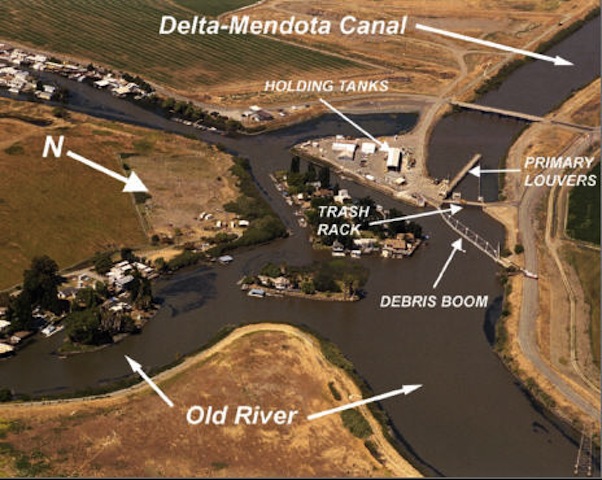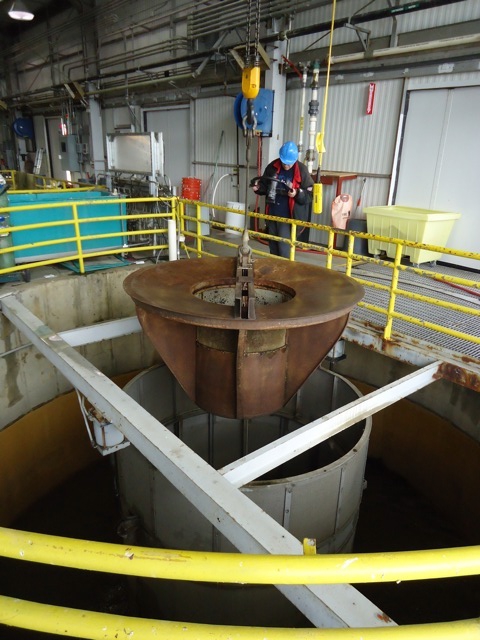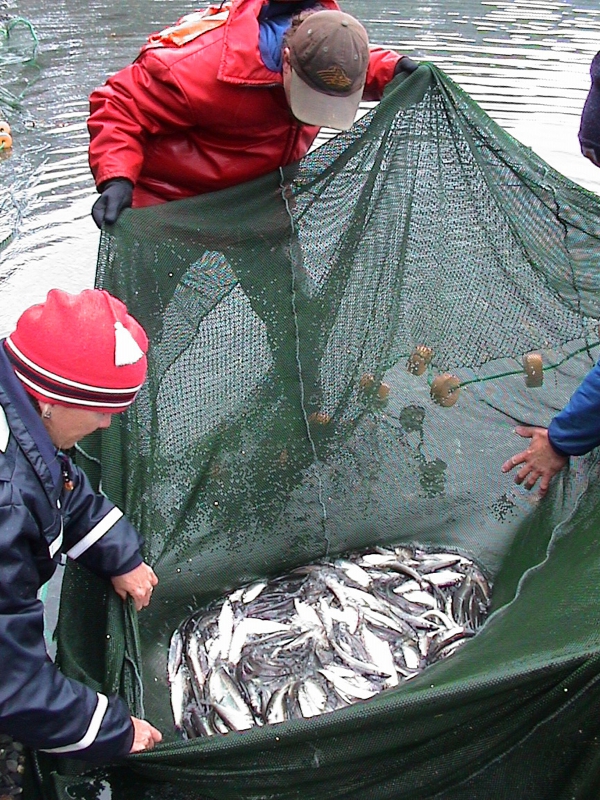From the Open-Publishing Calendar
From the Open-Publishing Newswire
Indybay Feature
Thousands of Pacific herring entrained in Delta pumps this year
“We’re bringing saltwater critters into the Delta,” quipped Bill Jennings, Executive Director of the California Sportfishing Protection Alliance. “How long will it be before sharks start showing in the Delta?”
This aerial photo shows the Tracy Fish Collection Facility (TFCF) on the South Delta. Photo by U.S. Bureau of Reclamation, Sacramento.
This aerial photo shows the Tracy Fish Collection Facility (TFCF) on the South Delta. Photo by U.S. Bureau of Reclamation, Sacramento.

Thousands of Pacific herring entrained in Delta pumps this year
by Dan Bacher
For commercial fishermen, the Pacific herring, Clupea pallasii, is the target of a valuable roe fishery in San Francisco Bay every winter.
For recreational fishermen, the Pacific herring is a popular bait to fish for salmon, lingcod, rockfish and other species with from a private or party boat.
For seafood connoisseurs, the Pacific herring provides a tasty feast, whether smoked, pickled or prepared fresh for the dinner table.
One place you wouldn’t expect to see herring, a marine fish, is at the Delta water pumping facilities near Tracy. But this is a record drought, aggravated by continued water exports at the Delta pumps, resulting in a minus 45 cfs inflow into San Francisco Bay in May.
One alarming indication of the increasing saltiness of the water of Delta water is the fact that a total of 1780 herring have been entrained at the Delta fish salvage facilities this year. This is the most fish since the drought of 1976 to 1977, according to Carl Wilcox, a Delta policy advisor for the California Department of Fish and Wildlife.
CDFW data reveals that a total of 1780 herring were recorded as “salvage” at the project facilities in February, March, and April. A total of 148 herring were reported in February, 1,597 in March and 35 in April.
“Most of the herring were in Suisun and San Pablo bays where catch per unit effort was as high as 300,000 per 10,000 cubic meters sampled,” noted Wilcox.
However, this was much less than in 1977, when a total of 35,641 fish were reported “salvaged.” In that year, 30 herring were reported in March, 2,082 in April, 17,843 in May, 6,370 in June, and 9,316 in July.
The herring are primarily a marine species spawning in Central San Francisco Bay, where the commercial fishery is focused, but they can spawn in brackish water also.
“They rear in the Bay during the summer, including San Pablo and Suisun bays, before moving into coastal waters,” said Wilcox. “Lower outflow associated with drought increases their presence in Suisun in the spring, although they can be found in all months in low numbers. They appear to move down bay in response to higher temperatures.”
The showing of herring at the pumps is uncommon; Pacific herring have only been documented at the pumps in 5 years, including 1977 and 2014. The other five years were 1984, when 116 fish were reported in December, 1985 when 79 herring were reported in July 79 and1991, when 10 fish were reported in March.
In response to my question about the temperature requirements for herring, Wilcox stated, “ Pacific herring have broad tolerance. When they were present in the Delta and Suisun Bay this year temperatures were not a concern. Temperature tolerances vary by life stage, but the young juveniles can tolerate the highest temperatures with the lowest salinities.”
In response to my question about how many herring drawn into the Delta may have perished from lethal water temperatures before they reached the pumping facilities, Wilcox said, “It is unlikely that temperatures were a problem since Pacific herring were absent from the Delta based on the 20 mm survey by the end of April and water temperatures were not elevated.”
“Once larval herring grow to a size that they can better control their movements, they would migrate downstream of the Delta fairly quickly to higher salinities,” he explained.
However, the real toll of herring that perished in the Delta pumping facilities is undoubtedly much higher than 1,780 fish, since predatory fish and birds feast on the fish around the pumps.
Pacific herring are “obligate” estuarine spawners, according to Dr. Jon Rosenfeld, biologist for the Bay Institute. In other words, they don't spawn in straight saltwater and cannot tolerate pure freshwater. Rosenfeld attributes the large showing of herring in the salvage facilities to the drought, combined with the rollback of state and federal Clean Water Act restrictions.
“While they would not have been spawning at the pumps (pure freshwater), it is not surprising that these fish would have been ‘exploring, for potential spawning habitat in that region of the Delta given how far east the salinity field was located in the spring of this year due to (a) the drought and (b) the rollback of Clean Water Act and state clean water regulations,” said Rosenfeld.
“Entrainment of any fish only occurs when exports occur, so the decision to reduce Delta outflow requirements while maintaining water export rates above levels needed for human health and safety certainly contributed to this loss of Pacific herring,” noted Rosenfeld.
There is no doubt that this is a record drought year, but the unusually salty conditions have been spurred by continuing water exports and the draining of Folsom, Oroville and Folsom Lake last year to provide water to subsidized corporate agribusiness interests farming drainage-impaired land on the west side of the San Joaquin Valley, as well as to fill Southern California reservoirs and supply water for oil companies conducting fracking and steam injection operations in Kern County.
At press time, there was 1133 cfs of water being exported through the State Water Project’s Harvey O. Banks Pumping Plant and another 566 cfs through the federal Central Valley Project’s Tracy Pumping Plant. That’s a total of 1,699 cfs.
“We’re bringing saltwater critters into the Delta,” quipped Bill Jennings, Executive Director of the California Sportfishing Protection Alliance. “How long will it be before sharks start showing in the Delta?”
Actually, a leopard shark was reported caught in the American River below Nimbus Dam in the fall of 1977. The angler, thinking he had hooked a salmon, was shocked when he brought the shark up to the bank. Realizing it was a very unusual catch, he quickly brought the shark to Nimbus Fish Hatchery, where they froze the shark so that biologists could examine it.
The state and federal water agencies have mismanaged northern California water so poorly that there was actually a minus 45 cubic feet per second (cfs) net outflow to the Bay this May, as documented by U.S. Geological Survey’s state-of-the-art UVM flow meters on the Sacramento and San Joaquin Rivers and Three-mile and Dutch Slough, Meanwhile, the Department of Water Resources and US Bureau of Reclamation were reporting a plus 3805 cfs.
While the Pacific herring population is relatively healthy, the Delta smelt population that lives entirely in the estuary is in dire straits this year.
“Last year, excessive water exports and low outflow drew delta smelt from Suisun Bay into the central Delta where they were butchered by lethal water temperatures," said Bill Jennings. “This year, with population levels hovering at historic lows: excessive transfers and exports, relaxed flow standards, high temperatures and negligible outflows may catapult the species into the abyss of extinction.”
Between 2000 and 2011, more than 130 million fish were “salvaged” at the state and federal project water export facilities in the South Delta, according to a white paper published in 2013 by the California Sportfishing Protection Alliance (CSPA) Recent estimates indicate that 5-10 times more fish are lost than are salvaged.
Pacific herring facts: This short-lived coastal pelagic species is found throughout the coastal zone from northern Baja California on the North American coast, around the rim of the North Pacific Basin to Korea on the Asian coast, according to the CDFW. In California, herring are found offshore during the spring and summer months foraging in the open ocean. The largest spawning aggregations in California occur in San Francisco and Tomales bays
by Dan Bacher
For commercial fishermen, the Pacific herring, Clupea pallasii, is the target of a valuable roe fishery in San Francisco Bay every winter.
For recreational fishermen, the Pacific herring is a popular bait to fish for salmon, lingcod, rockfish and other species with from a private or party boat.
For seafood connoisseurs, the Pacific herring provides a tasty feast, whether smoked, pickled or prepared fresh for the dinner table.
One place you wouldn’t expect to see herring, a marine fish, is at the Delta water pumping facilities near Tracy. But this is a record drought, aggravated by continued water exports at the Delta pumps, resulting in a minus 45 cfs inflow into San Francisco Bay in May.
One alarming indication of the increasing saltiness of the water of Delta water is the fact that a total of 1780 herring have been entrained at the Delta fish salvage facilities this year. This is the most fish since the drought of 1976 to 1977, according to Carl Wilcox, a Delta policy advisor for the California Department of Fish and Wildlife.
CDFW data reveals that a total of 1780 herring were recorded as “salvage” at the project facilities in February, March, and April. A total of 148 herring were reported in February, 1,597 in March and 35 in April.
“Most of the herring were in Suisun and San Pablo bays where catch per unit effort was as high as 300,000 per 10,000 cubic meters sampled,” noted Wilcox.
However, this was much less than in 1977, when a total of 35,641 fish were reported “salvaged.” In that year, 30 herring were reported in March, 2,082 in April, 17,843 in May, 6,370 in June, and 9,316 in July.
The herring are primarily a marine species spawning in Central San Francisco Bay, where the commercial fishery is focused, but they can spawn in brackish water also.
“They rear in the Bay during the summer, including San Pablo and Suisun bays, before moving into coastal waters,” said Wilcox. “Lower outflow associated with drought increases their presence in Suisun in the spring, although they can be found in all months in low numbers. They appear to move down bay in response to higher temperatures.”
The showing of herring at the pumps is uncommon; Pacific herring have only been documented at the pumps in 5 years, including 1977 and 2014. The other five years were 1984, when 116 fish were reported in December, 1985 when 79 herring were reported in July 79 and1991, when 10 fish were reported in March.
In response to my question about the temperature requirements for herring, Wilcox stated, “ Pacific herring have broad tolerance. When they were present in the Delta and Suisun Bay this year temperatures were not a concern. Temperature tolerances vary by life stage, but the young juveniles can tolerate the highest temperatures with the lowest salinities.”
In response to my question about how many herring drawn into the Delta may have perished from lethal water temperatures before they reached the pumping facilities, Wilcox said, “It is unlikely that temperatures were a problem since Pacific herring were absent from the Delta based on the 20 mm survey by the end of April and water temperatures were not elevated.”
“Once larval herring grow to a size that they can better control their movements, they would migrate downstream of the Delta fairly quickly to higher salinities,” he explained.
However, the real toll of herring that perished in the Delta pumping facilities is undoubtedly much higher than 1,780 fish, since predatory fish and birds feast on the fish around the pumps.
Pacific herring are “obligate” estuarine spawners, according to Dr. Jon Rosenfeld, biologist for the Bay Institute. In other words, they don't spawn in straight saltwater and cannot tolerate pure freshwater. Rosenfeld attributes the large showing of herring in the salvage facilities to the drought, combined with the rollback of state and federal Clean Water Act restrictions.
“While they would not have been spawning at the pumps (pure freshwater), it is not surprising that these fish would have been ‘exploring, for potential spawning habitat in that region of the Delta given how far east the salinity field was located in the spring of this year due to (a) the drought and (b) the rollback of Clean Water Act and state clean water regulations,” said Rosenfeld.
“Entrainment of any fish only occurs when exports occur, so the decision to reduce Delta outflow requirements while maintaining water export rates above levels needed for human health and safety certainly contributed to this loss of Pacific herring,” noted Rosenfeld.
There is no doubt that this is a record drought year, but the unusually salty conditions have been spurred by continuing water exports and the draining of Folsom, Oroville and Folsom Lake last year to provide water to subsidized corporate agribusiness interests farming drainage-impaired land on the west side of the San Joaquin Valley, as well as to fill Southern California reservoirs and supply water for oil companies conducting fracking and steam injection operations in Kern County.
At press time, there was 1133 cfs of water being exported through the State Water Project’s Harvey O. Banks Pumping Plant and another 566 cfs through the federal Central Valley Project’s Tracy Pumping Plant. That’s a total of 1,699 cfs.
“We’re bringing saltwater critters into the Delta,” quipped Bill Jennings, Executive Director of the California Sportfishing Protection Alliance. “How long will it be before sharks start showing in the Delta?”
Actually, a leopard shark was reported caught in the American River below Nimbus Dam in the fall of 1977. The angler, thinking he had hooked a salmon, was shocked when he brought the shark up to the bank. Realizing it was a very unusual catch, he quickly brought the shark to Nimbus Fish Hatchery, where they froze the shark so that biologists could examine it.
The state and federal water agencies have mismanaged northern California water so poorly that there was actually a minus 45 cubic feet per second (cfs) net outflow to the Bay this May, as documented by U.S. Geological Survey’s state-of-the-art UVM flow meters on the Sacramento and San Joaquin Rivers and Three-mile and Dutch Slough, Meanwhile, the Department of Water Resources and US Bureau of Reclamation were reporting a plus 3805 cfs.
While the Pacific herring population is relatively healthy, the Delta smelt population that lives entirely in the estuary is in dire straits this year.
“Last year, excessive water exports and low outflow drew delta smelt from Suisun Bay into the central Delta where they were butchered by lethal water temperatures," said Bill Jennings. “This year, with population levels hovering at historic lows: excessive transfers and exports, relaxed flow standards, high temperatures and negligible outflows may catapult the species into the abyss of extinction.”
Between 2000 and 2011, more than 130 million fish were “salvaged” at the state and federal project water export facilities in the South Delta, according to a white paper published in 2013 by the California Sportfishing Protection Alliance (CSPA) Recent estimates indicate that 5-10 times more fish are lost than are salvaged.
Pacific herring facts: This short-lived coastal pelagic species is found throughout the coastal zone from northern Baja California on the North American coast, around the rim of the North Pacific Basin to Korea on the Asian coast, according to the CDFW. In California, herring are found offshore during the spring and summer months foraging in the open ocean. The largest spawning aggregations in California occur in San Francisco and Tomales bays

Add Your Comments
We are 100% volunteer and depend on your participation to sustain our efforts!
Get Involved
If you'd like to help with maintaining or developing the website, contact us.
Publish
Publish your stories and upcoming events on Indybay.
Topics
More
Search Indybay's Archives
Advanced Search
►
▼
IMC Network



